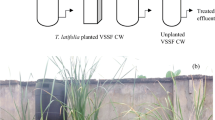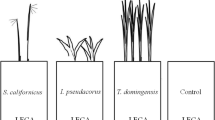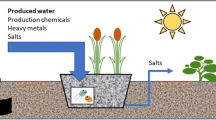Abstract
Typha latifolia-planted vertical subsurface flow constructed wetlands (VSSF CWs) can be used to treat petroleum refinery wastewater. This study evaluated if the removal efficiency of VSSF CWs can be improved by changing the plant species or coupling horizontal subsurface flow constructed wetlands (HSSF CWs) to the VSSF CW systems. The VSSF CWs had a removal efficiency of 76% for biological oxygen demand (BOD5), 73% for chemical oxygen demand (COD), 70% for ammonium-N (NH4+-N), 68% for nitrate-N (NO3−-N), 49% for phosphate (PO43−-P), 68% for total suspended solids (TSS), and 89% for turbidity. The HSSF CWs planted with T. latifolia further reduced the contaminant load of the VSSF CW-treated effluent, giving an additional removal efficiency of 74, 65, 43, 65, 58, 50, and 75% for, respectively, BOD5, COD, NH4+-N, NO3−-N, PO43−-P, TSS, and turbidity. The combined hybrid CW showed, therefore, an improved effluent quality with overall removal efficiencies of, respectively, 94% for BOD5, 88% for COD, 84% for NH4+-N, 89% for NO3−-N, 78% for PO43−-P, 85% for TSS, and 97% for turbidity. T. latifolia strived well in the VSSF and HSSF CWs, which may have contributed to the high NH4 +-N, NO3−-N, and PO43−-P removal efficiencies. T. latifolia-planted VSSF CWs showed a higher contaminant removal efficiency compared to the unplanted VSSF CW. T. latifolia is thus a suitable plant species for treatment of secondary refinery wastewater. Also a T. latifolia-planted hybrid CW is a viable alternative for the treatment of secondary refinery wastewater under the prevailing climatic conditions in Nigeria.











Similar content being viewed by others
References
Abidi, S., Kallali, H., Jedidi, N., Bouzaiane, O., & Hassen, A. (2009). Comparative pilot study of the performances of two constructed wetland wastewater treatment hybrid systems. Desalination, 246, 370–377.
Abou-Elela, S. I., & Hellal, M. S. (2012). Municipal wastewater treatment using vertical flow constructed wetlands planted with Canna, Phragmites and Cyprus. Ecological Engineering, 47, 209–213. https://doi.org/10.1016/j.ecoleng.2012.06.044.
Adomokai, R., & Sheate, W. R. (2004). Community participation and environmental decision-making in the Niger Delta. Environmental Impact Assessment Review, 24, 495–518. https://doi.org/10.1016/j.eiar.2004.01.002.
Agbenin, J. O., Danko, M., & Welp, G. (2009). Soil and vegetable compositional relationships of eight potentially toxic metals in urban garden fields from northern Nigeria. Journal of Science, Food and Agriculture, 89(1), 49–54. https://doi.org/10.1002/jsfa.3409.
APHA. (2002). Standard methods for the examination of water and wastewater (20th ed.). Baltimore: American Public Health Association.
Ávila, C., Garfí, M., & García, J. (2013). Three-stage hybrid constructed wetland system for wastewater treatment and reuse in warm climate regions. Ecological Engineering, 43–49. doi:https://doi.org/10.1016/j.ecoleng.2013.09.048
Bialowiec, A., Albuquerque, A., & Randerson, P. F. (2014). The influence of evapotranspiration on vertical flow subsurface constructed wetland performance. Ecological Engineering, 67, 89–94. https://doi.org/10.1016/j.ecoleng.2014.03.032.
Calheiros, C., Rangel, A., & Castro, P. (2007). Constructed wetland systems vegetated with different plants applied to the treatment of tannery wastewater. Water Research, 41, 1790–1798. https://doi.org/10.1016/j.watres.2007.01.012.
Calheiros, C. S., Rangel, A. O., & Castro, P. M. (2009). Treatment of industrial wastewater with two-stage constructed wetlands planted with Typha latifolia and Phragmites australis. Bioresources Technology, 100(13), 3205–3213.
Chung, A., Wu, Y., Tam, N. F., & Wong, M. H. (2008). Nitrogen and phosphate mass balance in a sub-surface flow constructed wetland for treating municipal wastewater. Ecological Engineering, 32, 81–89. https://doi.org/10.1016/j.ecoleng.2007.09.007.
Chyan, J.-M., Senoro, D.-B., Lin, C.-J., Chen, P.-J., & Chen, M.-L. (2013). A novel biofilm carrier for pollutant removal in a constructed wetland based on waste rubber tire chips. International Biodeterioration & Biodegradation, In Press, 1–8. doi:https://doi.org/10.1016/j.ibiod.2013.04.010.
Czudar, A., Gyulai, I., Kereszturi, P., Csatari, I., Serra-Paka, S., & Lakatos, G. (2011). Removal of organic materials and plant nutrients in a constructed wetlands for petrochemical wastewater treatment. Studia Universitatis “Vasile Goldiş”, Seria Ştiinţele Vieţii, 21(1), 109–114. Retrieved january 4, 2015, from (www.studiauniversitatis.ro).
Dhulap, V. P., Ghorade, I. B., & Patil, S. S. (2014). Seasonal study and its impact on sewage treatment in the angular horizontal subsurface flow constructed wetlands using aquatic macrophytes. International Journal of Research in Engineering & Technology, 2(5), 213–224.
Dipu, S., Anju, A., Kumar, V., & Thanga, S. G. (2010). Phytoremediation of dairy effluent by constructed wetland technology using wetland macrophytes. Global Journal of Environmental Research, 4(2).
FEPA. (1991). Guidelines and Standards for Environmental Pollution Control in Nigeria. National Environmental Standards-Parts 2 and 3. Lagos, Lagos, Nigeria: Government Press.
Haberl, R., Grego, S., Langergraber, G., Kadlec, R. H., Cicalini, A.-R., Dias, S. M., Novais, J. M., Aubert, S., Gerth, A., Thomas, H., & Hebner, A. (2003). Constructed wetlands for the treatment of organic pollutants. Journal of Soils and Sediments, 3(2), 109–124. https://doi.org/10.1007/BF02991077.
Hagahmed, D. E., Gasmelseed, G. A., & Ahmed, S. E. (2014). Multiple loops control of oil biodegradation in constructed wetlands. Journal of Applied and Industrial Sciences, 2(1), 6–13 Retrieved January 4, 2015.
Herrera Melián, J., Martín Rodríguez, A. J., Araña, J., González Díaz, O., & González Henríquez, J. (2010). Hybrid constructed wetlands for wastewater treatment and reuse in the Canary Island. Ecological Engineering, 36, 891–899. https://doi.org/10.1016/j.ecoleng.2010.03.009.
Hietala, K. A., & Roane, T. M. (2009). Microbial remediation of metals in soils. In A. Singh, R. Kuhad, & O. Ward (Eds.), Advances in Applied Bioremediation, Book series: Soil Biology (vol. 17, pp. 201–220). Berlin, Heidelberg: Springer. https://doi.org/10.1007/978-3-540-89621-0_11.
Israel, A. U., Obot, I. B., Umoren, S. A., Mkepenie, V., & Ebong, G. A. (2008). Effluents and solid waste analysis in a petrochemical company—a case study of Eleme Petrochemical Company Ltd, Port Harcourt, Nigeria. E-Journal of Chemistry, 5(1), 74–80 Retrieved from http://www.e-journals.net.
Isumonah, V. A. (2015). Minority political mobilization in the struggle for resource control in Nigeria. The Extractive Industries and Society, 2, 645–653. https://doi.org/10.1016/j.exis.2015.04.011.
Ji, G. D., Sun, T. H., & Ni, J. R. (2007). Surface flow constructed wetland for heavy oil-produced water treatment. Bioresource Technology, 98(2), 436–441.
Kantawanichkul, S., Pilaila, S., Tanapiyawanich, W., & Kamkrua, S. (1999). Wastewater treatment by tropical plants in vertical-flow constructed wetlandss. Water Science and Technology, 40(3), 173–178. https://doi.org/10.1016/S0273-1223(99)00462-X.
Kaseva, M. E. (2004). Performance of a sub-surface flow constructed wetland in polishing pre-treated wastewater - a tropical study. Water Research, 38, 681–687. https://doi.org/10.1016/j.watres.2003.10.041.
Katsenovich, Y. P., Hummel-Batista, A., Ravinet, A. J., & Miller, J. F. (2009). Performance evaluation of constructed wetlands in a tropical region. Ecological Engineering, 35, 1529–1537. https://doi.org/10.1016/j.ecoleng.2009.07.003.
Kivaisi, A. K. (2001). The potential for constructed wetlands for wastewater treatment and reuse in developing countries; a review. Ecological Engineering, 16, 545–560.
Madera-Parra, C. A., Pena-Salamanca, E. J., Pena, M., Rousseau, D. P., & Lens, P. N. (2015). Phytoremediation of landfill leachate with Colocasia esculenta, Gynerum sagittatum and Heliconia psittacorum in constructed wetlands. International Journal of Phytoremediation, 17, 16–24. https://doi.org/10.1080/15226514.2013.828014.
Masi, F., & Martinuzzi, N. (2007). Constructed wetlands for the Mediterranean countries: Hybrid systems for water reuse and sustainable sanitation. Desalination, 215, 44–55. https://doi.org/10.1016/j.desal.2006.11.014.
Mena, J., Rodriguez, L., Numez, J., Fermandez, F. J., & Villasenor, J. (2008). Design of horizontal and vertical subsurface flow constructed wetlands treating industrial wastewater. Water Pollution, 555–557. doi:https://doi.org/10.2495/WP080551.
Mitchell, C., & McNevin, D. (2001). Alternative analysis of BOD removal in subsurface flow constructed wetlands employing Monod kinetics. Water Research, 1295–1303.
Murray-Gulde, C., Heatley, J. E., Karanfil, T., Rodgers Jr., J. R., & Myers, J. E. (2003). Performance of a hybrid reverse osmosis-constructed wetland treatment system for brackish oil field produced water. Water Research, 37(3), 705–713.
Mustapha, H. I., van Bruggen, J. J. A., & Lens, P. N. L. (2015). Vertical subsurface flow coonstructed wetlands for polishing secondary Kaduna refinery wastewater in Nigeria. Ecological Engineering, 85, 588–595. https://doi.org/10.1016/j.ecoleng.2015.09.060.
NIMET. (2010). Nigeria Meteorological Agency, Nigeria. Kaduna, Kaduna, Nigeria.
Nwanyanwu, C. E., & Abu, G. O. (2010). In vitro effects of petroleum refinery wastewater on dehydrogenase activity in marine bacterial strains. Ambi-Agua, Taubatè, 5(2), 21–29. doi:https://doi.org/10.4136/ambi-agua.133.
Ojumu, T. V., Bello, O. O., Sonibare, J. A., & Solomon, B. O. (2005). Evaluation of microbial systems for bioremediation of petroleum refinery effluents in Nigeria. African Journal of Biotechnology, 4(1), 31–35 Retrieved from http://www.academicjournals.org/AJB.
Peng, J.-F., Wang, B.-Z., & Wang, L. (2005). Multi-stage ponds-wetlands ecosystem for effective wastewater treatment. Journal of Zhejiang University Science, 6B(5), 346–352 Retrieved January 5, 2015, from http://www.zju.edu.cn/jzus.
Saeed, T., & Guangzhi, S. (2012). A review on nitrogen and organics removal mechanisms in subsurfaceflow constructed wetlands: Dependency on environmental parameters, operating conditions and supporting media. Journal of Environmental Management, 112, 429–448. https://doi.org/10.1016/j.jenvman.2012.08.011.
Saien, J., & Shahrezaei, F. (2012). Organic pollutants removal from petroleum refinery wastewater with nanotitania photocatalyst and UV light emission. International Journal of Photoenergy, 2012, 1–5. https://doi.org/10.1155/2012/703074.
Sawaittayothin, V., & Polpraser, C. (2007). Nitrogen mass balance and microbial analysis of constructed wetlands treating municipal landfill leachate. Bioresource Technology, 98, 565–570. https://doi.org/10.1016/j.biortech.2006.02.002.
Seeger, E. A., Kuschk, P., Fazekas, H., Grathwohl, P., & Kaestner, M. (2011). Bioremediation of benzene-, MTBE- and ammonia-contaminated groundwater with pilot-scale constructed wetlands. Environmental Pollution, 159, 3769–3776. https://doi.org/10.1016/j.envpol.2011.07.019.
Senewo, I. D. (2015). The Ogoni Bill of Rights (OBR): extent of actualization 25 years later? The Extractive Industries and Society(2), 664–670. doi:https://doi.org/10.1016/j.exis.2015.06.004.
Sepahi, A. A., Golpasha, I. D., Emami, M., & Nakhoda, A. M. (2008). Isolation and characterization of crude oil degrading Bacillus spp. Iranian Journal Environmental Health, Science and Engineering, 5(3), 149–154.
Stottmeister, U., Wießner, A., Kuschk, P., Kappelmeyer, U., Kästner, M., Bederski, O., Müller, R. A., Moormann, H. (2003). Effects of plants and microorganisms in constructed wetlands for wastewater treatment. Biotechnology Advances, 22(1-2), 93–117. https://doi.org/10.1016/j.biotechadv.2003.08.010.
Sun, G., & Austin, D. (2007). Completely autotrophic nitrogen-removal over nitrite in lab-scale constructed wetlands: Evidence from a mass balance study. Chemosphere, 68, 1120–1128. https://doi.org/10.1016/j.chemosphere.2007.01.060.
Travaini-Lima, F., & Sipaúba-Tavares, H. L. (2012). Efficiency of a constructed wetland for wastewaters treatment. Acta Limnologica Brasiliensia, 24(3), 255–265.
Vymazal, J. (2005). Horizontal sub-surface flow and hybrid constructed wetlands systems for wastewater treatment. Ecological Engineering, 25, 478–490. https://doi.org/10.1016/j.ecoleng.2005.07.010.
Wenyin, C., Zhanghe, C., Qifan, H., Xiaoyan, W., Cairong, W., Dafeng, C., & Zenglong, L. (2007). Root growth of wetland plants with different root types. Acta Ecologica Sinica, 27(2), 450–458.
Weyens, N., van der Lelie, D., Taghavi, S., & Vangronsveld, J. (2009). Phytoremediation: plant-endophyte partnerships take the challenge. Current Opinion in Biotechnology, 20(2), 248–254. https://doi.org/10.1016/j.copbio.2009.02.012.
Yeh, T. Y., & Wu, C. H. (2009). Pollutant removal within hybrid constructed wetland systems in tropical regions. Water Science and Technology , 233–240.
Zapater-Pereyra, M., Ilyas, S., van Bruggen, J., & Lens, P. (2015). Evaluation of the performance and space requirement by three different hybrid constructed wetlands in a stack arrangement. Ecological Engineering, 82, 290–300. https://doi.org/10.1016/j.ecoleng.2015.04.097.
Zeb, B. S., Mahmood, Q., Jadoon, S., Pervez, A., Irshad, M., Bilal, M., & Bhatti, Z. A. (2013). Combined industrial wastewater treatment in anaerobic bioreactor posttreated in constructed wetland. BioMedical Research International, 2013, 1–8. Retrieved January 4, 2015, from. https://doi.org/10.1155/2013/957853.
Zhang, D.-Q., Jinadasa, K., Gersberg, R. M., Liu, Y., Tan, S. K., & Ng, W. J. (2015). Application of constructed wetlands for wastewater treatment in tropical and subtropical regions (2000–2013). Journal of Environmental Sciences, 30, 30–46. https://doi.org/10.1016/j.jes.2014.10.013.
Zurita, F., & White, J. R. (2014). Comparative study of three two-stage hybrid ecological wastewater systems for producing high nutrient, reclaimed water for irrigationreuse in developing countries. Water, 6, 213–228. https://doi.org/10.3390/w6020213.
Acknowledgements
The authors acknowledge the Netherlands Fellowship Program (NFP) for financial support (NFP-PhD CF7447/2011). Also, the staff of the UNESCO-IHE laboratory and the staff and management of Kaduna Refinery and Petrochemical Company (Kaduna, Nigeria) are acknowledged for their support.
Author information
Authors and Affiliations
Corresponding author
Ethics declarations
Conflict of Interest
The authors declare that they have no conflict of interest.
Rights and permissions
About this article
Cite this article
Mustapha, H.I., van Bruggen, J.J.A. & Lens, P.N.L. Optimization of Petroleum Refinery Wastewater Treatment by Vertical Flow Constructed Wetlands Under Tropical Conditions: Plant Species Selection and Polishing by a Horizontal Flow Constructed Wetland. Water Air Soil Pollut 229, 137 (2018). https://doi.org/10.1007/s11270-018-3776-3
Received:
Accepted:
Published:
DOI: https://doi.org/10.1007/s11270-018-3776-3




